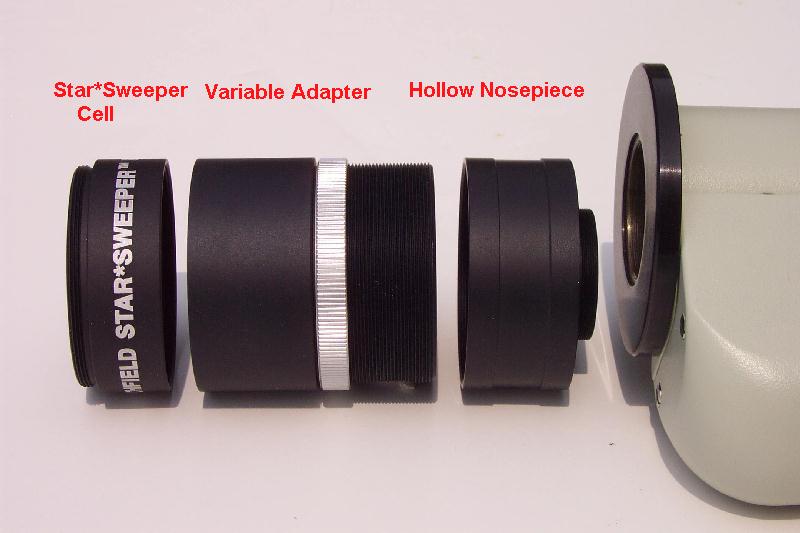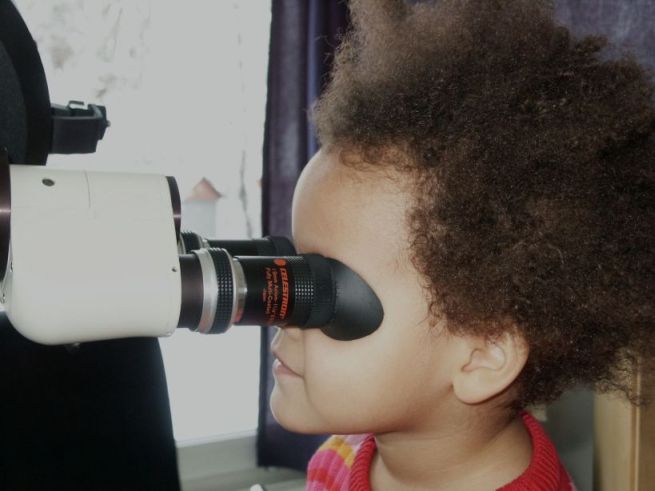The
Denkmeier Standard Binoviewer has
emerged to become the most
popular binoviewer over the last
two years with sales in: USA,
Canada, Dominican Republic, Great
Britain, Norway, Switzerland,
Hong Kong, Singapore, South
Korea, Germany, France, Spain,
Portugal, Sweden, New Zealand,
Australia and Guam. On any given
night, astronomy enthusiasts all
over the globe are viewing the
heavens with a Denkmeier
Binoviewer. We are proud to be
the originators of the Patent
Pending Denkmeier Optical
Corrector System (OCS)™
that has allowed access to
low-power views of the sky with
two eyes. The use of our OCS, SCT
Richfield Star*Sweeper™,
and the Denkmeier Deepsky series
of Binoviewers has started a
revolution that is sure to
culminate in two-eye use being
the norm very soon.
About Our Standard Binoviewer
Our Denkmeier Standard Binoviewer
has superb optical quality for
Planet, Lunar, Solar and Deepsky
use. Every Standard Binoviewer is
available as part of a package.
These “Packages” are
divided into three types:
Standard SCT Package, Standard
Newtonian Package, and Standard
Refractor Package. Each Standard
Package includes a hard plastic
case with interior foam pads and
the corrector system for the
particular telescope being used.
If more than one telescope is
being used, corrector components
may be added to allow use with
all of your telescopes.
By “Corrector
Components”, we mean that
each telescope design will
benefit from an optical
peripheral device to allow the
Binoviewer to work at a variety
of powers. For example, the
“Standard SCT Package”
contains the SCT Richfield
Star*Sweeper. This allows an F/10
SCT to also operate at F/5 with
The Denkmeier Binoviewer.
The “Standard Newtonian
Package” allows any
Newtonian Telescope as well as
Maksutovs, Cassagrains, and a
variety of other reflector
designs to operate at powers as
low as 1.2X and also at 2.5X.
With “Standard Refractor
Packages”, your refractor
and Denkmeier Binoviewer with OCS
for refractors will focus at
powers as low as 1.2X and as high
as 3X. All OCS accessories
included with Standard Packages
are in a 1.25” format. The
OCS included with Standard
Refractor Packages will allow the
1.25” OCS to be installed
into a 2” diagonal with
included “Part T”
adapter.
The Standard Binoviewer has
prisms with standard MgF2
coatings. These coatings are very
easy to produce in a consistent
manner. The efficiency is defined
as Anti-Reflective (AR) and there
are 7 air to glass surfaces where
transmission occurs. Each surface
has an AR rating of 1.6% which
translates into 11% reflectivity
or 89% transmission. Compare this
to the Denkmeier II AR rating of
0.25% or 1.75% reflectivity or
otherwise stated as 98.25%
transmission. The Standard
Binoviewer performance is well
documented. Please see our
“Testimonial” page or
see our “Links” page
for direction to very impartial
reviews. Also check out our
“Review” page for more
information.
Standard Newtonian Package:
Includes 1.25” Newtonian
OCS™ .
Standard Refractor Package:
Includes 1.25” Refractor OCS
and Part T for 2” diagonals
Standard SCT Package: Includes
SCT Richfield Star*Sweeper™
for 2” Star Diagonals (Note:
Any 2” Star Diagonal allows
use of this accessory. See
“SCT” use).
All Denkmeier Standard
Binoviewers are shipped with case
and accessory. Plastic plugs and
caps are included for the
Binoviewer and OCS units.
Machined metal caps are included
for the SCT Richfield
Star*Sweeper. Machined caps and
plugs are available separately.
One set of machined eyepiece
plugs and cap for Binoviewer is
$29.95. 1.25” caps for the
OCS are $14.99 for one pair.
Standard Binoviewer Logo Caps
say, “Deepsky
Binoviewer” while Denkmeier
II Binoviewer Logo Caps always
say,
“Dielectric-Coatings”.
All Standard Packages are $599 +
S/H and are available for
worldwide delivery. Standard
Packages are always in stock.
2” Accessories
The 1.25” OCS accessories
may be substituted for 2”
OCS units for both Newtonians and
Refractors. Call for pricing.
 The image above
shows how the Patent Pending SCT
Richfield Star*Sweeper transforms
an SCT into a versatile binocular
telescope of varying focal
lengths. This is easily
accomplished by screwing a cell
onto the two-inch hollow
nosepiece (included with all
Star*Sweepers).
Note that the Two Inch Nosepiece
may be used without the
Star*Sweeper Cell. It is threaded
for 48mm filters. The Two Inch
Hollow Nosepiece is on the right
side of the image. The
magnification gained as a result
of moving an SCT primary mirror
toward the secondary when turning
the focuser know is approximately
15% so that an F/10 becomes an
F/11.5. This occurs because the
spherical primary and concave
secondary increase the focal
length of the system as the
spacing is reduced via turning of
the SCT focuser knob.
The Star*Sweeper cell contains a
custom designed, Fully
Multi-Coated Optic (FMC) produced
by Denkmeier Optical, Inc. With
most SCTs*, the Star*Sweeper
produces a true F/5 image with
The Denkmeier Binoviewer. All
Star*Sweepers are housed in our
CNC fabricated, 100% anodized
aluminum Stealth Black
Baffled™ tubing. We machine
the entire assembly right down to
the aluminum retaining rings that
hold the optics in place.
When a wide F/5 field is desired,
simply remove the binoviewer from
the 2”star diagonal and
screw on the Star*Sweeper cell
just like you would do to install
a filter. Yes, the Star*Sweeper
Cell and the 2” Hollow
Nosepiece are precision threaded
for 48mm filters. Your SCT
becomes a Giant Low Powered
Binocular in seconds. A pair of
20mm Wide field eyepieces now
operate as if they were 40mm wide
field eyepieces.
*With some specialty SCTs like
the C9.25, the classic SCT
Richfield Star*Sweeper may not
focus. Denkmeier Optical now
offers a special version that
allows the C9.25 to reach focus
and the reduction factor allows
approximately F/7 viewing but
this depends on the visual back,
focuser and adapters that one
uses on their particular scope.
We await more feedback from
Maksutov users. We demonstrated
the conventional SCT Richfield
Star*Sweeper on a 7” Questar
which allowed focus to be reached
easily, due to the abundant
back-focus that that model
supplies.

The Variable adapter
allows even more focal reduction
when used in conjunction with The
SCT Richfield Star*Sweeper.
F/ratios of F4.3 have been
reported on some SCTs using the
Patent Pending Variable Adapter
in combination with the SCT
Richfield Star*Sweeper. As shown
in the illustration, the Variable
Adapter increases the space
between the Star*Sweeper Cell and
the Binoviewer
Nosepiece/Binoviewer. This
reduces magnification and the
distance is adjustable so that
many SCTs may utilize this
feature for maximum low power
applications.
Importantly, the use of the
Variable Adapter requires
additional turns of the SCT
focuser and some SCTs may not
have those turns available. This
varies from scope to scope, in
part due to the variety of visual
backs, after-market focusers, and
adapters being used today by
amateurs. This is why the
Variable Adapter has been
designed as an optional
accessory. Had it been integrated
into the Star*Sweeper as a
one-piece unit, some users would
not reach focus.
Note that the amount of spacing
that the Variable Adapter creates
is adjustable by the user and can
be secured with the silver ring
when that ring is screwed flush
to the Hollow Nosepiece. As
always, the Variable Adapter is a
precision machined, Stealth
Baffled anodized aluminum
accessory. This ensures that
maximum contrast will be the case
on every object being viewed.

Instruction on use
of The SCT Richfield Star*Sweeper
Refer to drawing above:The
Star*Sweeper cell is shown at the
left in the drawing(C). This
Star*Sweeper Cell contains the
optical component that allows
your SCT to operate at half the
normal magnification in the case
of a typical F/10 SCT. This cell
can be screwed to the threads of
the 2" Nosepiece (A) shown
2nd in from the right. The far
right object represents the
Binoviewer's opening where the
2" nosepiece is screwed
into. If the Binoviewer and
2" Nosepiece are used
without the Star*Sweeper Cell,
slightly higher than normal power
is the result. This is due to the
primary mirror in the SCT having
to move closer to the secondary
mirror to allow the binoviewer to
focus. Basically, a gain of about
12% power is created by the
primary/Secondary relationship.
Using just the 2" Nosepiece
and the binoviewer in your SCT is
very desirable for medium power
observations of planets,
galaxies, The Moon, nebula and
star clusters. The 2"
Nosepiece is threaded for filters
(48mm/2").
For ultra low-power views, the
Star*Sweeper Cell may now be
attached by threading it to the
end of the 2" Nosepiece. The
process is very quick and similar
to the action required to add a
typical 2" filter to an
eyepiece. The result of
installing the Star*Sweeper Cell
is a beautiful widefield view of
star clusters, galaxies, nebula
and even the Moon. The
Star*Sweeper Cell is also
threaded for 48mm/2"
filters. Using The SCT Richfield
Star*Sweeper is very desriable
for low surface brightness
objects (LSBO) like M51, M33 and
other objects like large star
clusters and extended nebula. Of
course, The Star*Sweeper can be
used for anything that might be
intersting to see at low power.
For even lower power views than
F/5, the Variable Adapter(B) may
be installed between the
Star*Sweeper Cell and The 2"
Nosepiece. This is used as a
spacer and increases the distance
of the Star*Sweeper Cell from the
Binoviewer/2"Nosepiece. This
results in very low powers and
focal ratios faster than F/5
which means, wider fields of
view. The amount of spacing may
be increased or decreased by
screwing or unscrewing the
Variable Adapter from the 2"
Nosepiece. Remember that the
greater the distance that The
Star*Sweeper Cell/Optics are
placed from the Binoviewer, the
more backfocus is needed. The
ability of your SCT to provide
this backfocus will be the
determining factor in how low the
resulting power becomes. Certain
SCTs provide more backfocus than
others and this will vary with
the accessories that one adds to
their SCT (ex: Focusers,visual
backs,filter wheels). The lower
the profile of your visual back,
the better. Filter wheels and
electric focusers can create
enough added profile so that the
Variable Adapter will ot be
usable. Note that the locking
ring (D) is used to retain the
2" Nosepiece/Variable
Adapter position. It need not be
screwed flush to the 2"
Nosepiece very tightly. Once the
desired relationship of the
Variable Adapter and
2"Nosepiece has been
established, the silver lock ring
may be screwed flush to the
2" Nosepiece to ensure
stability of the coupling.

Bought the 23 10
2003 Hands
on optic
©2003 Denkmeier
Optical, Inc. Patent Pending
|